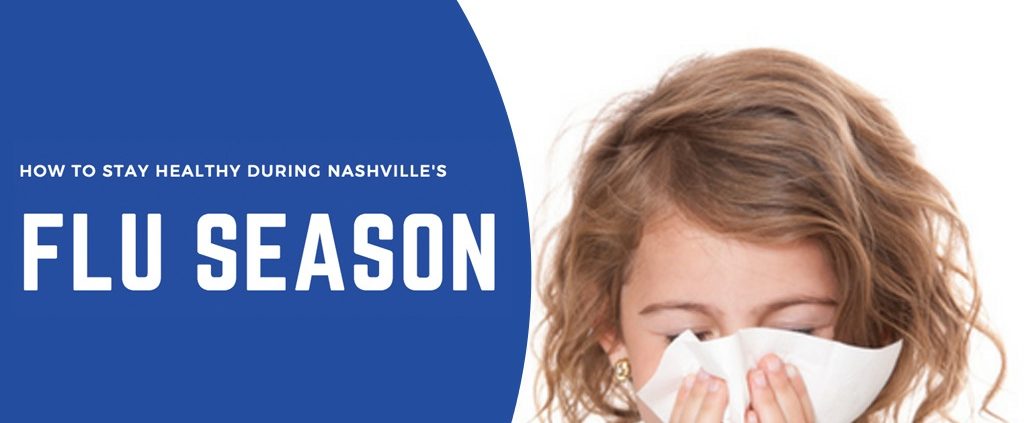Does My Baby Have a Cold? 7 of the Most Common Signs
/in Uncategorized/by Nicole ClawsonFirst words. First steps. First cold.
Of all the exciting milestones for your baby, the first cold is probably furthest from your mind. Babies start building their immune systems the moment they are born, but it takes time to develop full protection. During this vulnerable time, they can have up to 10 colds each year, more if they attend daycare or other crowded, public environments. Compare this to an average of four annual colds for most adults!
During winter weather, more time is spent indoors where viruses can live on surfaces for hours. Children experience the world by touching things and inevitably those hands make it into their mouths.
With that in mind, the best thing to do when you think your baby is coming down with a cold is to follow the guidance of your baby’s pediatrician. Please contact St. Thomas Medical Group pediatricians at +1 (615) 301-7040.
Symptoms of Colds in Babies
Apart from the common cold symptoms like fever, runny nose, cough, and congestion, younger children and babies may display a variety of other signs. Here are 7 common signs your child may be coming down with an upper respiratory infection.
- Refusal to nurse or take a bottle. Infants and older children tend to have decreased appetite when they are coming down with a cold. If your child suddenly has less interest in breastfeeding or formula, he or she should be evaluated by a pediatrician to help determine if there is a cold developing.
- Listlessness. Babies are naturally active and curious. When your child becomes less interested in the environment or people around them, the sudden change in energy level may be indicative of an infection like a cold. It’s always important to seek pediatric care if you have any concerns.
- Irritability. Excessive fussiness, crying and tantrums may be a sign that your baby is not feeling well. Because babies can’t talk, crying is a baby’s primary way of communicating. Over time, parents learn to decipher the baby’s cries and what they mean, but if your baby is irritable and cries longer than usual, it might be a sign that your baby is ill or in pain.
- Fewer wet diapers. Colds and illness can cause dehydration through fever, sweating, vomiting, or diarrhea. Less frequent need for diaper changes could indicate developing dehydration. Babies can quickly become dangerously dehydrated, so this should be communicated to your child’s pediatrician immediately.
- Difficulty sleeping. We all know how hard it is to get good rest with a cold. A stuffy head, runny nose, and cough can keep you awake. It is no different for your baby. Changes in sleep routine can have many causes, but cold viruses top the list.
- Pale or rosy cheeks. This type of change to your baby’s complexion may be a sign that they are becoming ill. Aside from pale or rosy cheeks, keep an eye on your baby’s skin or lips. If they turn blue or purple, then call the pediatrician immediately.
- Swollen or sunken soft spot. Your baby’s soft spot, or fontanelle, can change depending on illness and hydration status. Both ends of the spectrum, excessive pressure or decreased fullness, can represent a medical emergency and should be evaluated by a pediatrician immediately. In Nashville, the doctors at St. Thomas Medical Group are the best pediatricians to help care for your baby.
Ambiguous Symptoms
Sometimes what may seem like a clear sign of a cold can be allergies, indigestion or another benign condition.
- Nasal irritation can come from an infection like a cold, but can also be triggered by allergies or dry winter air.
- Vomiting and diarrhea. While many infants have some gastrointestinal upset related to colds, these symptoms are more commonly associated with other conditions.
- Red eyes can accompany other cold symptoms but may also be from allergies or bacterial conjunctivitis (aka pink eye) and would be treated differently in this case.
Nothing to Sneeze At
It is important to keep in mind that most illnesses, including colds, can be higher risk for children compared to adults. In addition, many of the medications used to manage cold symptoms in adults are not safe for young children.
If you have any question about your baby’s health, please do not hesitate to contact the excellent pediatricians at St. Thomas Medical Group. You can schedule an appointment with our Nashville pediatricians by calling +1 (615) 301-7040.
Stay Healthy This Winter With 5 Fun Exercise Classes
/in Uncategorized/by Nicole ClawsonThis January brought one of the coldest starts to a new year in recent memory. With lows dipping down into the single digits, many Nashvillians were loathe to venture outdoors for exercise. And who can blame them? Going for a bike ride on an icy road or setting out for a jog without the proper cold-weather exercise clothing can sometimes do more harm than good.
This winter, stay healthy with some fun (mainly indoors) exercise classes and fitness opportunities.
Climb Nashville
Indoor rock climbing has rapidly grown in popularity during recent years. The sport is likely to see even more growth when it’s officially added to the Olympic Games in 2020. Today, Nashvillians have more options than ever for indoor rock climbing.
Don’t miss Climb Nashville West’s staggering walls for some adrenaline-pumping top-rope action. Or, for a more low-key experience, head over to their East Location and try your forearms at some bouldering (low, rope-free climbing).
Nashvillians on the south side of the city should check out The Crag Nashville, which opened its doors in 2017.
HOTBOX Fitness Nashville
Rock climbing is a great way to build strength for the slow-and-steady types, but a kickboxing class will throw you straight into a full-sweat, calorie-burning experience. Located in the Gulch, HOTBOX is a kickboxing experience unlike any other. With a focus on fitness (as opposed to martial arts), these primarily female classes are a great way to get out of the cold and warm up!
East Nasty Running Club
If a little cold weather doesn’t bother you, then check out the East Nasty Running Club, which meets Wednesday evenings at 6:00 p.m. at the corner of 11th and Holly. Each week, the pack heads out for a three to six mile route that winds through East Nashville. You don’t have to be a “runner” to join. If you’re under an 11-minute mile, start with the “Lasty Nasty” group at 5:45!
Inner Light Yoga
Located in 12 South, Inner Light Yoga boasts a “West Coast vibe” and “Southern hospitality” that integrates music, rhythm and beats into flows. Not your typical yoga session, Inner Light Yoga puts music at the core of the practice. Plus, they’ve always got the studio heated to approximately 75 ºF, making it the perfect escape from whatever frigid temperatures Nashville might bring our way!
Verticity Indoor Cycling Studio
Verticity takes indoor cycling to the next level with high-energy group classes that will leave you completely wiped by the end! If you’re looking to get an excellent (indoor) cardio workout, pay a visit to the Five Points area studio that will make you completely rethink the phrase “stationary bike.”
Whatever You Choose, Get Your Exercise!
The Department of Health and Human Services recommends adults get at least 150 minutes of moderate aerobic activity or 75 minutes of vigorous aerobic activity each week. That’s just 30 minutes a day, five days a week. In addition to aerobic activity, look for ways to incorporate strength training and reduce time spent sitting.
See a Primary Care Doctor In Nashville, TN
Need help developing an exercise plan for 2018? Doctors at St. Thomas Medical Group have helped hundreds of patients take control of their own health and create positive change. To schedule an appointment with a board-certified doctor in Nashville, contact St. Thomas Medical Group by calling +1 (615) 297-2700. Our physicians have offered quality care at the intersection of Green Hills, Sylvan Park and Belle Meade for over 40 years.
How to Stay Healthy Through Nashville’s Flu Season
/in Uncategorized/by Nicole ClawsonAs winter weather continues, so do the aches, coughs, and chills. You’ve probably read the headlines about this year’s specific strain of influenza being the most widespread since the Centers for Disease Control and Prevention began its current surveillance system 13 years ago. In fact, the flu hospitalization rate is at the highest number ever recorded at this point in the season.
Fortunately, despite the scary headlines, there are steps you can actively take to stay healthy this flu season. Even if you get sick with flu symptoms, our Nashville doctors are here to make sure you get the medical care you need to return to life as normal.
Flu Prevention Techniques You Can Practice Today
By following these tips, you can minimize your risk of getting the flu. Of course, there is no fool-proof way to completely slow or stop the spread of the flu, but we encourage you to take the following actions to protect yourself and others.
- Get vaccinated! You might be wondering, “Is it too late to get a flu shot this season?” While getting a vaccine is better earlier in the season, there are still a few weeks to go and vaccination could provide some benefit. Even if this year’s flu vaccine isn’t the best match, it can help reduce the severity of the flu and minimize downtime if you do get sick.
- Practice healthy hygiene and good cleaning habits. One of the best ways to avoid the flu is to regularly wash your hands, especially before eating. Use soap and water for at least 20 seconds, rubbing in circles, cleaning between your fingers, and scrubbing under your nails. Also take the time to regularly clean and disinfect surfaces that may be contaminated. Focus on areas that are touched frequently such as countertops, door knobs, faucets, and even your cell phone!
- Avoid close contact with sick people. Families are especially at risk for spreading the flu between family members. While it is important to care for each other, it is equally important to limit contact as much as possible. It can be difficult to avoid someone with the flu if you’re the one taking care of them, but if possible, try to give them their own room for sleeping and recovery.
- Exercise and sleep. Getting the recommended amount of sleep is one of the best things you can do for your immune system. When your body is well rested, it can help aid you in flu prevention. Regular exercise can also help boost your body’s defenses.
- See your primary care physician. With the exception of emergency warning signs or complications, most patients do not need to go to the Emergency Room to care for the flu. If you get sick with flu-like symptoms but have a non-emergency illness, see your primary care doctor instead. Going to the ER can expose you to others who have it, increasing the likelihood of infection.
When to Seek Medical Attention
The good news is that the majority of symptoms associated with the flu typically last about a week and will subside with home treatment. However, the flu can lead to serious complications that require medical attention. If you experience difficulty breathing, chest or stomach pain, dizziness or lightheadedness, or severe vomiting, you should call your doctor. These red flags are universal for both adults and children.
At St. Thomas Medical Group, we know how important flu prevention is for your quality of life. If you get flu-like symptoms, we’re also here to help you get healthy as quickly as possible. Whether you’re a new or returning patient, you can make an appointment online today or call us at +1 (615) 297-2700.




